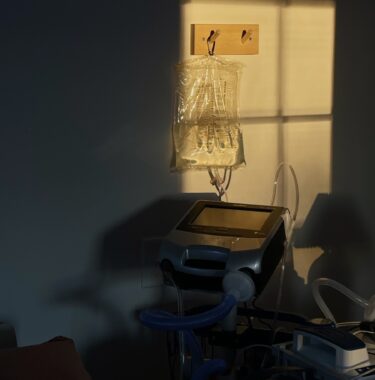How I manage an overwhelming amount of medical supplies
Finding sanctuary at home amid all of my medical equipment

In my childhood home, we didn’t have a coat closet. Or, to be more specific, we did have a coat closet, but the space was overtaken by a higher priority. Instead of holding winter jackets, it was packed full of medical supplies. A tower of mismatched storage bins and cardboard boxes held the various items I utilized for the daily management of my pulmonary hypertension (PH).
Central line care kits, sterile water, backup CADD pumps, and the batteries they required were all delivered to our house regularly and stored away in their respective containers. Little things seeped past that closet door — the pill tray in my nightstand drawer, the Remodulin (treprostinil) bottle we kept slotted in the butter tray in our refrigerator.
I’m not sure I thought about this much growing up. But then, when I was 15, we added an oxygen concentrator to the mix. I stored this bulky item in my bedroom closet. Embarrassed by its existence, I kept it tightly concealed, only cracking open the door and unwinding the long nasal cannula for use at bedtime.
My awareness of these supplies multiplied when I moved into a dorm for college. The small space compressed these unwanted companions inward, toppling over me at every turn. My dependency on various medications and treatments became that much more undeniable.
Following my heart-lung transplant in 2018, I dreamed of a day when the evidence of my need for medical care would disappear completely. I yearned to once again have it all minimized, concealed easily behind a closet door.
It seems the opposite has taken place. Chronic illness families sometimes depict the idea of running an ICU from home. This is a near-perfect description of my circumstance. If you strip away the furniture, my bedside closely resembles that of a hospital bed.
There’s my ventilator and the recognizable blue and white tubing it requires, a suction machine, a nebulizing machine, a machine for using my vest … the list goes on. And right across the hall from my room is a familiar sight — a closet stuffed to the brim with containers of medical supplies. The excess can now be found in the guest room closet. Needless to say, there’s more than ever before.
These landscapes that surround me often feel sterile and inhuman. I’m exhausted by these interventions that I cannot escape. And as someone who is greatly impacted by the appearance of her surrounding environment, it weighs on me to always be faced with so many devices and objects I would never choose to live with.
Learning to compromise
This isn’t a problem with a simple solution. In place of abandoning these supplies altogether, an option that my health simply can’t permit, I look for compromises.
First, I opt to keep some spaces in my life completely free of medical infiltration. For now, this means my art studio, a space that holds a great deal of sacred meaning for me. Aside from a few vials of medication in the mini-fridge, this room remains untouched.
I also work hard to minimize and organize my medical supplies as best I can. Just recently, I completely removed a large IV pole attachment from my ventilator stand. This pole was used to hang a large humidification bag of water, which now resides on a hook on my wall.

An image of Anna’s bedside. Highlighted is a humidification bag hanging on a hook. Anna’s ventilator is pictured just below. (Photo by Anna Jeter)
Finally, I’m making an effort to still care for this space and all it holds. Since moving here in 2020, I’ve been slow to decorate my room, and have even been apathetic about cleaning. For a long time, it felt like there was no point. I was always living with a trash can that spilled over with medical waste, and piles of supplies that would simply be refreshed once they started running low.
But lately, after a winter of hospital stays, this home feels like a sanctuary more than ever. So I’m trying to honor it. I’m keeping things as tidy as possible, and hanging art that I’ve neglected for months. I’m ordering furniture where it’s still needed, and doing my best not to be bummed out at night as I switch on all of my various devices.
Even as I continue to struggle emotionally with the support this body requires, I’m also making an effort to live well with these intrusions that have been beside me since childhood. And for once, the weight they present feels like one I can manage.
Note: Pulmonary Hypertension News is strictly a news and information website about the disease. It does not provide medical advice, diagnosis, or treatment. This content is not intended to be a substitute for professional medical advice, diagnosis, or treatment. Always seek the advice of your physician or other qualified health provider with any questions you may have regarding a medical condition. Never disregard professional medical advice or delay in seeking it because of something you have read on this website. The opinions expressed in this column are not those of Pulmonary Hypertension News or its parent company, Bionews, and are intended to spark discussion about issues pertaining to pulmonary hypertension.









Kavya Pharma
There is so much that resonates with this essay-managing medical supplies isn't just about keeping them organized, it's also about preserving dignity, comfort, and hope. It is deeply inspiring to see your strategies, such as keeping sacred spaces, maximizing storage, and treating the home like a sanctuary.